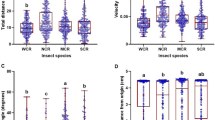Abstract
Volatile chemicals from corn silks attractedDiabrotica virgifera virgifera LeConte andD. barberi (Smith and Lawrence). The behavioral response of both species of beetles to the host plant was typified by four distinct phases: perception, random movement, orientation to the source, and search with reorientation. The perception phase was composed of stationary behaviors, while the random, orientation, and search phases were composed of directed and nondirected movements. Each of the movement phases had a characteristic response pattern composed of the ratio of upwind, lateral, and downwind walking and flight movements, which affected net displacement of the beetle in the flight tunnel. The perception phase occurred within and between the other phases and was responsible for initiating changes from one movement phase to another (based on the presence or absence of volatiles from corn silks). Host finding was flexible, and the response pattern fit a flow-chart type of response, rather than a single stereotyped sequence of behaviors.
Similar content being viewed by others
References
Ball, H.J. 1957. On the biology and egg-laying habits of the western corn rootworm.J. Econ. Entomol. 50:126–128.
Baker, T.C., andCardé, R.T. 1979. Courtship behavior of the oriental fruit moth (Grapholitha molesta): Experimental analysis and consideration of the role of sexual selection in the evolution of courtship pheromones in lepidoptera.Ann. Entomol. Soc. Am. 72:173–188.
Branson, T.F., andKrysan, J.L. 1981. Feeding and oviposition behavior and life cycle strategies ofDiabrotica: An evolutionary view with implications for pest management.Environ. Entomol. 10:826–831.
Branson, T.F., andOrtman, E.E. 1971. Host range of larvae of the northern corn rootworm: Further studies.J. Kans. Entomol. Soc. 44:50–52.
Bruss, R.G. 1981. Intrafield dispersal of adult corn rootworms. Ph.D. dissertation. Iowa State University, Ames, Iowa.
Cinereski, J.E., andChiang, H.C. 1968. The pattern of movements of adults of the northern corn rootworm inside and outside of cornfields.J. Econ. Entomol. 61:1531–1536.
Dindonis, L.L., andMiller, J.R. 1980. Host-finding behavior of onion flies,Hylemya antiqua.Environ. Entomol. 9:769–772.
Ferguson, J.E., Metcalf, E.R., Metcalf, R.L., andRhodes, A.M. 1983. Influence of cucurbitacin content in cotyledons of cucurbitacea cultivars upon feeding behavior of diabroticine beetles (Coleoptera: Chrysomelidae).J. Econ. Entomol. 76:47–51.
Hawkes, C., Patton, S., andCoaker, T.H. 1978. Mechanisms of host plant finding in adult cabbage root fly,Delia brassicae.Entomol. Exp. Appl. 24:419–427.
Hill, R.E., andMayo, ZB 1980. Distribution and abundance of corn rootworm species as influenced by topography and crop rotation in eastern Nebraska.Environ. Entomol. 9:122–127.
Hintz, A.M., andGeorge, B.W. 1966. Field cage observations of northern and western corn rootworm populations.Proc. North Cent. Branch Entomol. Soc. Am. 21:41.
Linn, C.E., Jr., andRoelofs, W.L. 1983. Effect of varying proportions of the alcohol component on sex pheromone blend discrimination in male Oriental fruit moths.Physiol. Entomol. 8:291–306.
Ludwig, K.A., andHill, R.E. 1975. Comparison of gut contents of adult western and northern corn rootworms in northeast Nebraska.Environ. Entomol. 4:435–438.
Matin, M.A., andYule, W.N. 1984. Effects of corn phenology on spatial distribution and population estimation of adult northern corn rootworms (Coleoptera: Chrysomelidae).J. Econ. Entomol. 77:1176–1179.
Metcalf, R.L., Rhodes, A.M., Metcalf, R.A., Ferguson, J.E., Metcalf, E.R., andLu, P.-Y. 1982. Cucurbitacin content and diabroticite (Coleoptera: Chrysomelidae) feeding uponCucurbit spp.Environ.Entomol. 11:931–937.
Shorey, H.H. 1973. Behavioral responses to insect pheromones.Annu. Rev. Entomol. 18:349–380.
Teal, P.E.A., McLaughlin, J.R., andTumlinson, J.H. 1981. Analysis of the reproductive behavior ofHeliothis virescens (F.) under laboratory conditions.Ann. Entomol. Soc. Am. 74:324–330.
Van Woerkom, G.J., Turpin, F.T., andBarrett, J.R., Jr. 1980. Influence of constant and changing temperatures on locomotor activity of adult western corn rootworms (Diabrotica virgifera) in the laboratory.Environ. Entomol. 9:32–34.
Van Woerkom, G.J., Turpin, F.T., andBarrett, J.R., Jr. 1983. Wind effect on western com rootworm (Coleoptera: Chrysomelidae) flight behavior.Environ. Entomol. 12:196–200.
Author information
Authors and Affiliations
Rights and permissions
About this article
Cite this article
Prystupa, B., Ellis, C.R. & Teal, P.E.A. Attraction of adultDiabrotica (Coleoptera: Chrysomelidae) to corn silks and analysis of the host-finding response. J Chem Ecol 14, 635–651 (1988). https://doi.org/10.1007/BF01013912
Received:
Accepted:
Issue Date:
DOI: https://doi.org/10.1007/BF01013912




